Episode 133: STS-61 - Closing the Door on Spherical Aberration (HST Servicing 1)
Table of Contents
The Hubble Space Telescope is in trouble. With the fate of the orbiting observatory, and maybe NASA itself, on the line, can the crew of STS-61 save the day? We’ll ride along in the latest episode of The Space Above Us.
Episode Audio #
Photos #
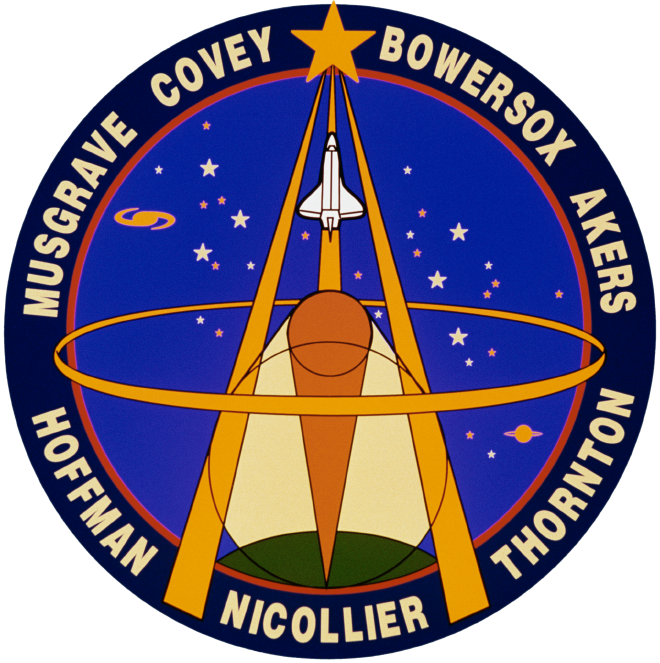
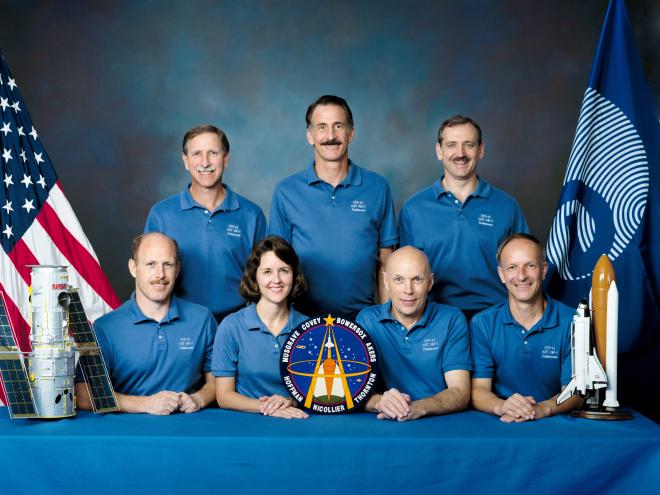
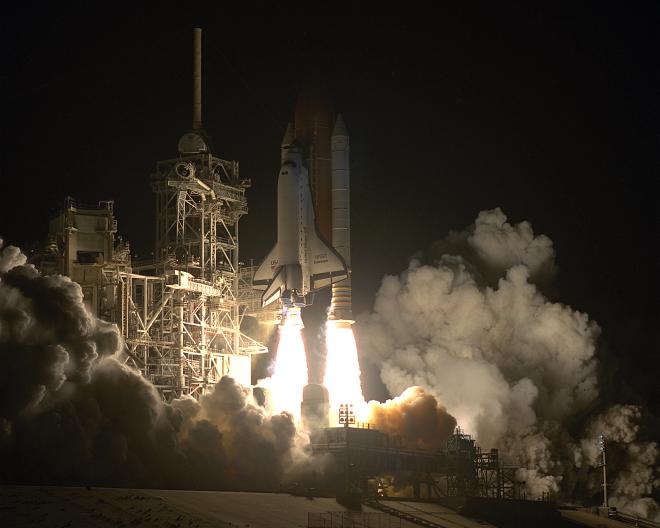
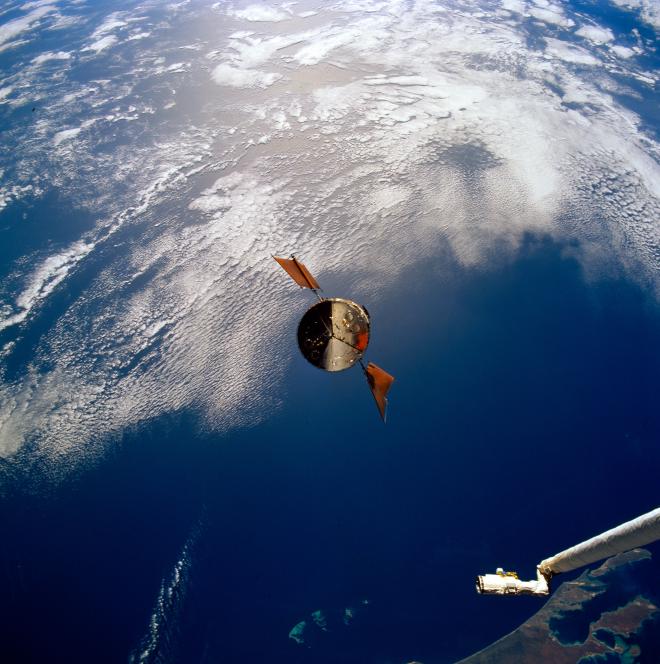

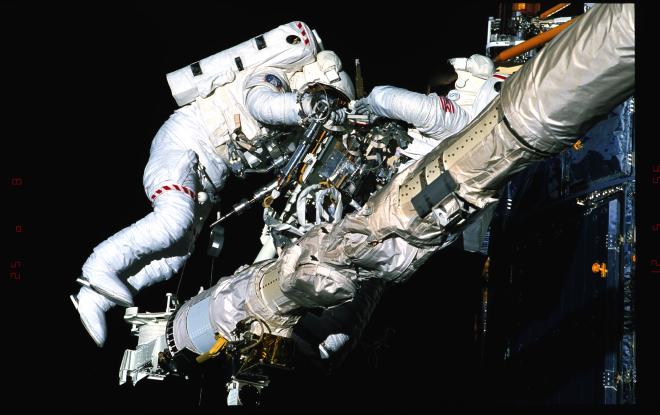
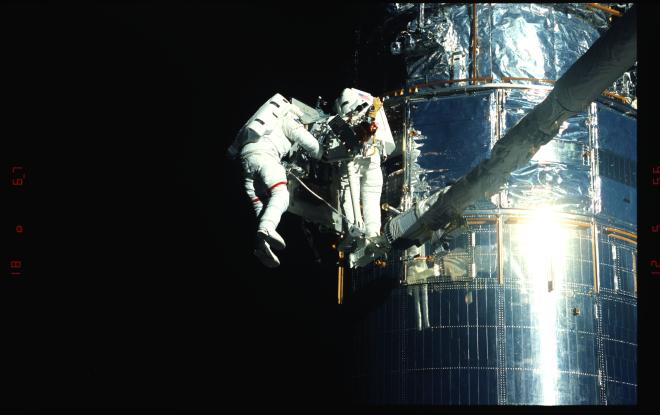
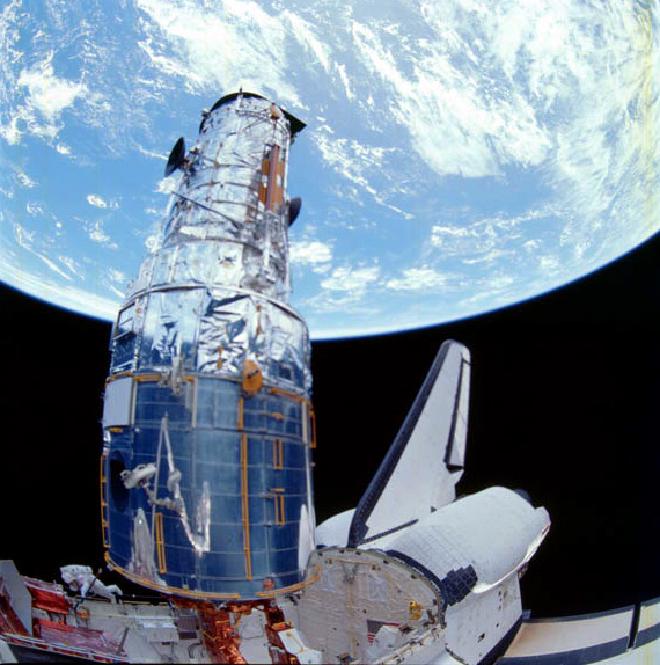
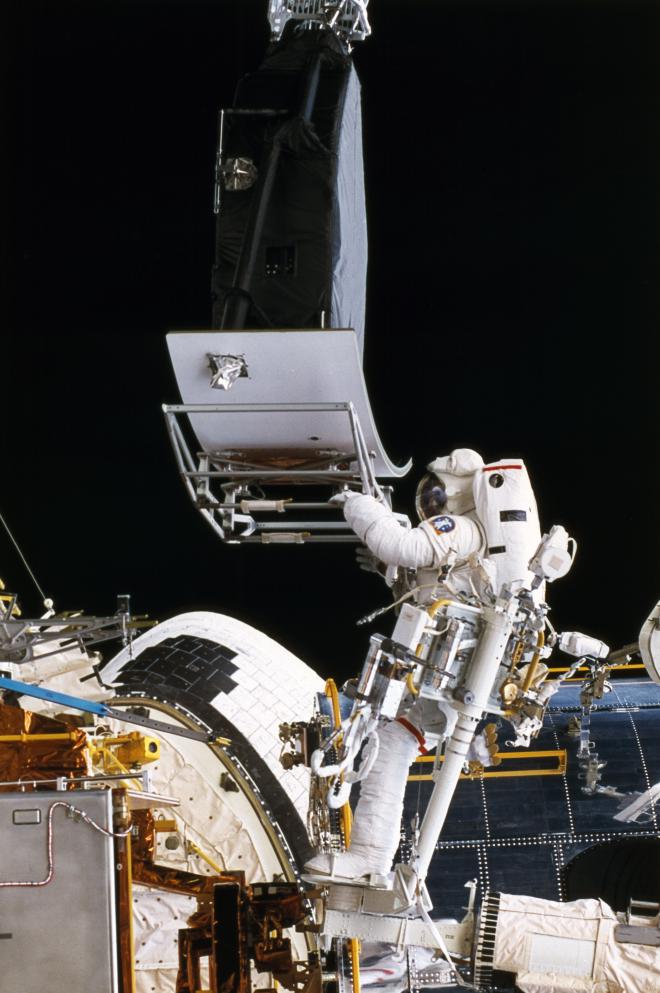
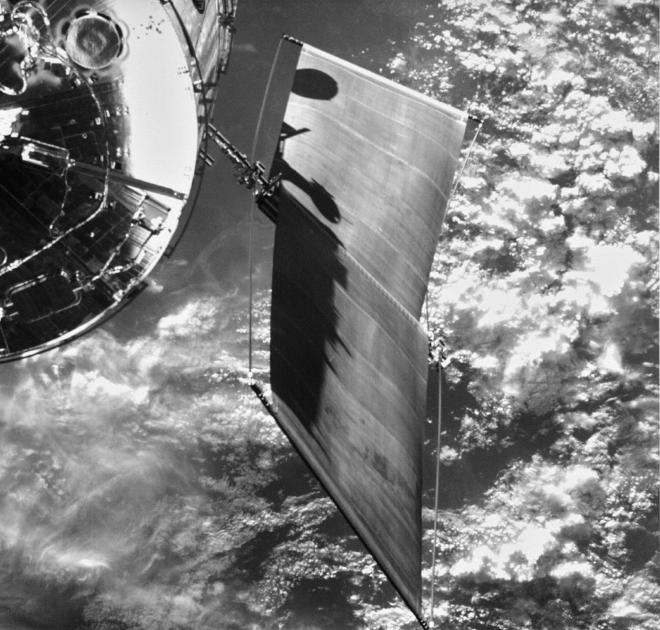
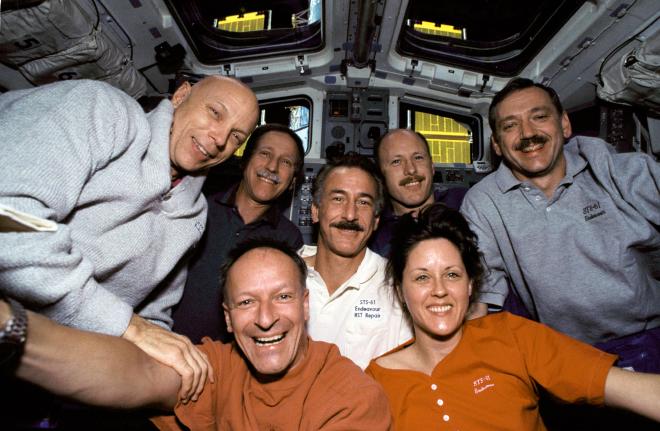
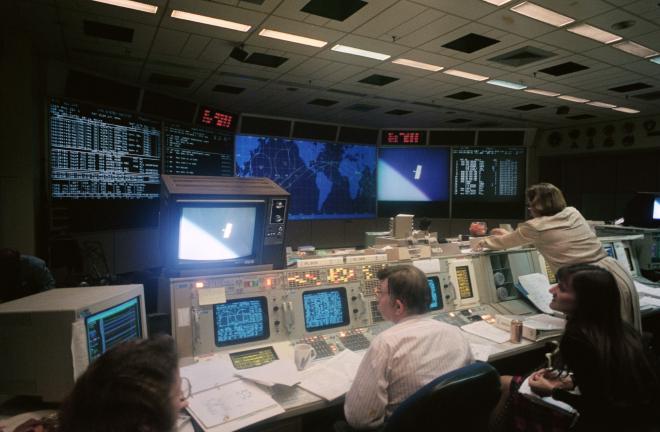
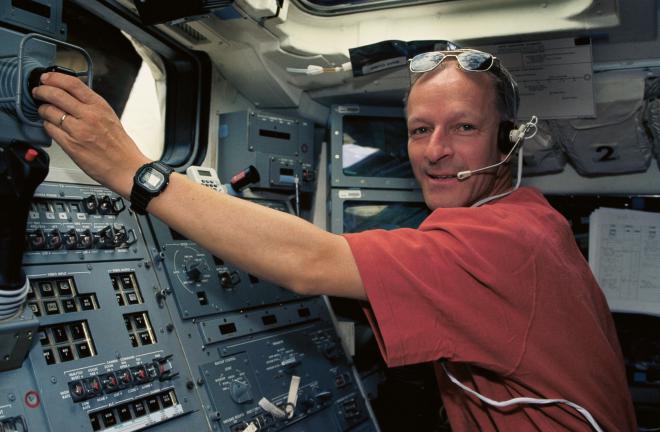
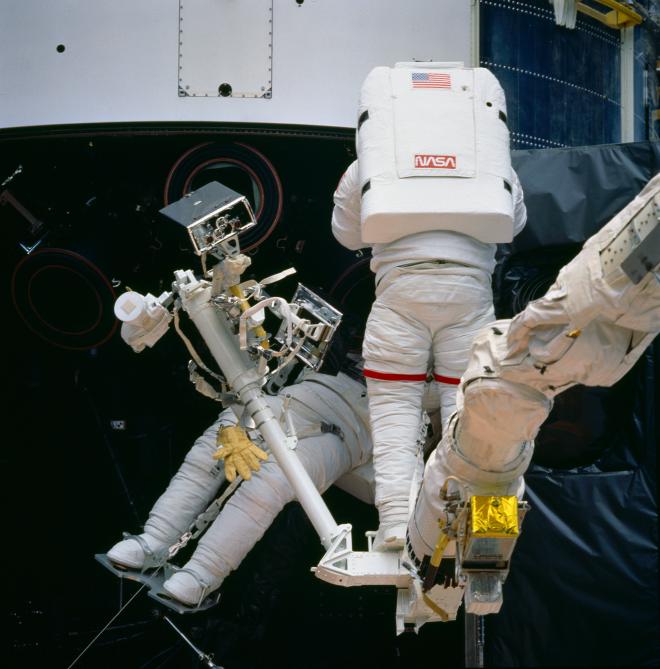
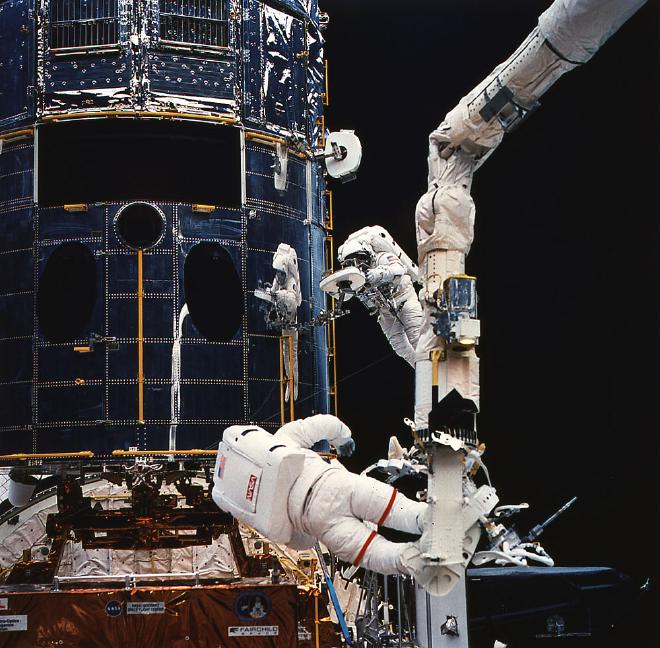
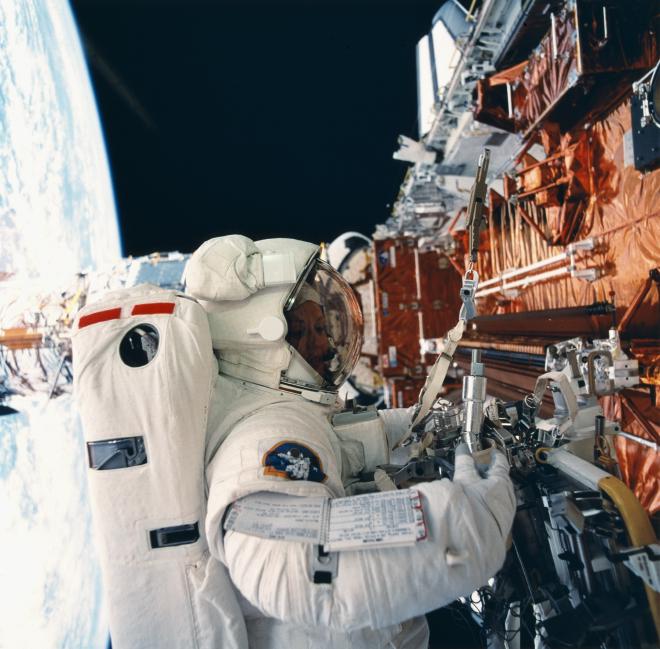
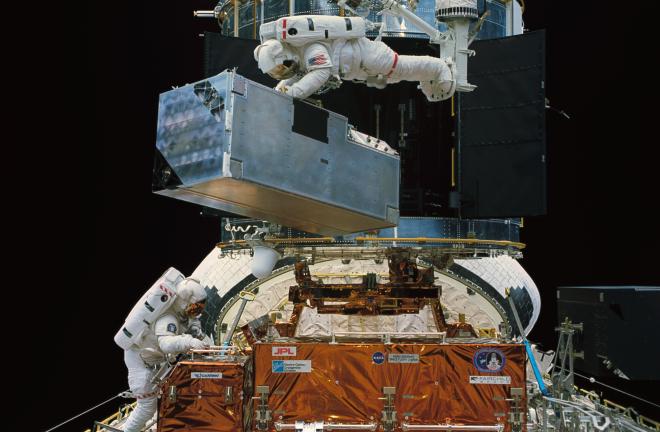
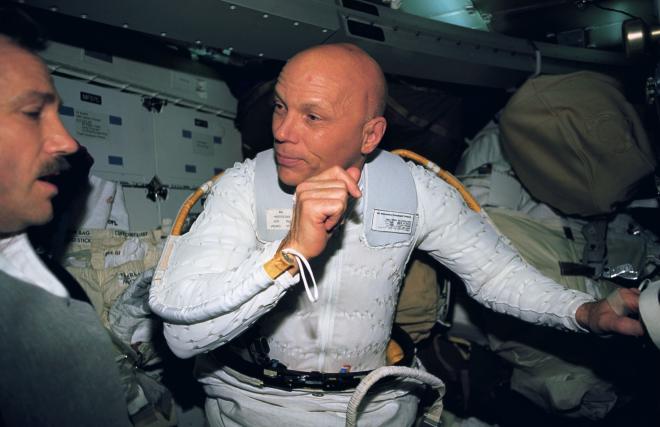
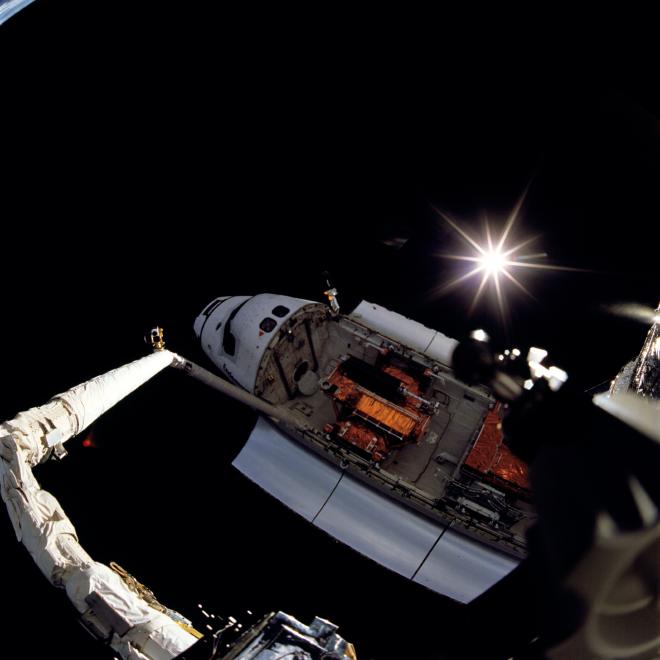
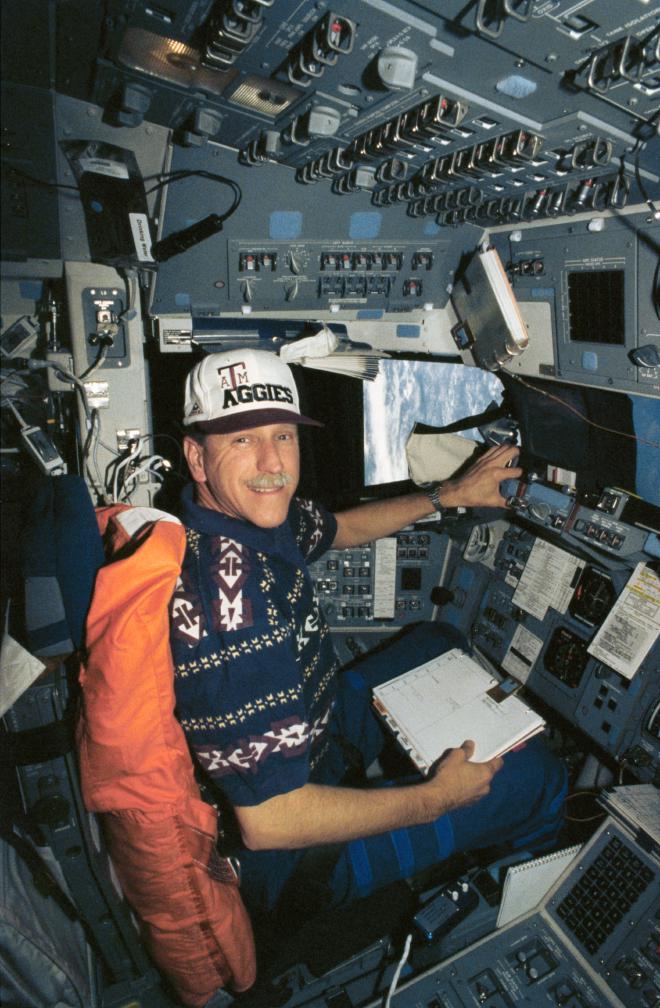
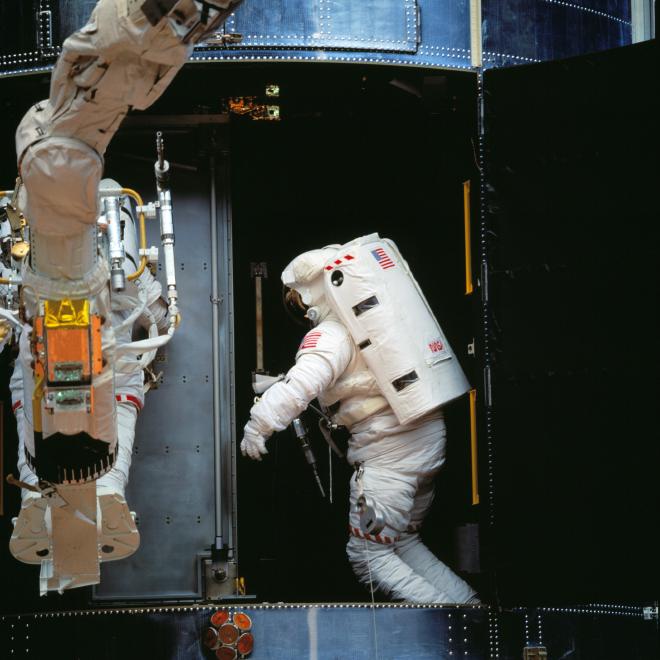
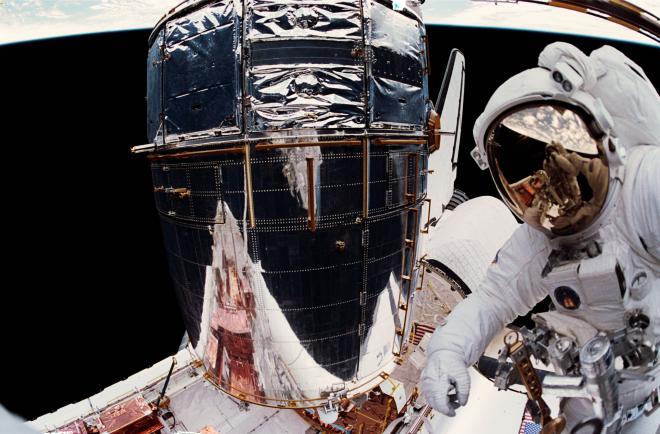
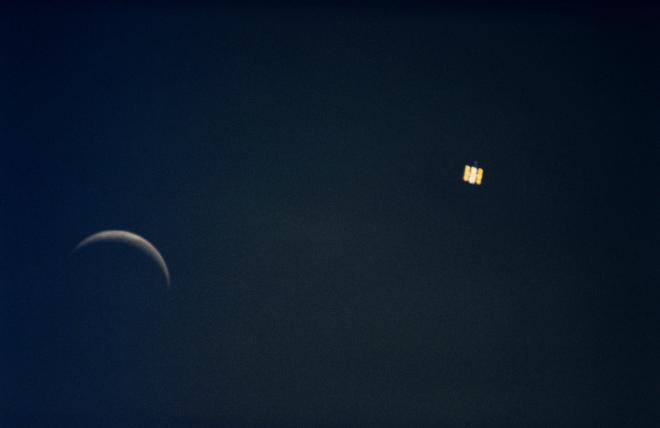
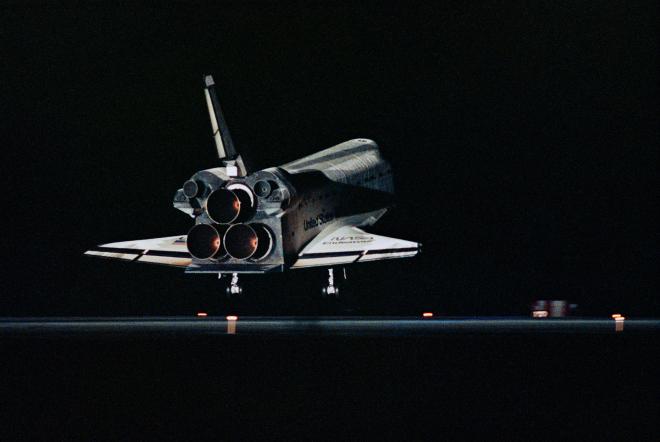
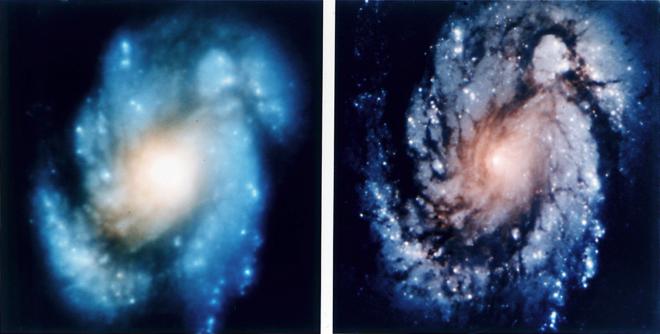
Post-Flight Presentation #
If you’d like to see the mission in motion you can check out the post-flight presentation here:
Home Improvement Appearance #
Here’s the crew’s appearance on Home Improvement.
Full length EVA videos via C-SPAN #
These videos won’t embed here, but since they’re eight hours long you probably want to give them their own tab anyway.
Transcript #
NOTE: This transcript was made by me just copying and pasting the script that I read to make the podcast. I often tweak the phrasing on the fly and then forget to update the script, so this is not guaranteed to align perfectly with the episode audio, but it should be pretty close. Also, since these are really only intended to be read by myself, I might use some funky punctuation to help remind myself how I want a sentence to flow, so don’t look to these as a grammar reference. If you notice any egregious transcription errors or notes to myself that I neglected to remove, feel free to let me know and I’ll fix it.
Hello, and welcome to The Space Above Us. Episode 133, Space Shuttle Flight 59, STS-61: Closing the Door on Spherical Aberration
Last time, we dug deep into the inner workings of the optical manufacturing company Perkin-Elmer. We learned how they had planned to construct the primary mirror for the Hubble Space Telescope, and how that plan didn’t quite work out as expected. We learned the importance of sanity checks, the value of proper documentation, and just how small 2200 nanometers really is.
2200 nanometers is an almost inconceivably small error, but it would go on to have major ramifications. Shortly after its successful deployment in 1990, the Hubble Space Telescope found itself not the vaunted scientific masterpiece NASA that had hoped, but a punchline, an embarrassment, a disaster. In addition to a sizable monetary loss, Perkin-Elmer’s blunder had caused incalculable damage to NASA’s reputation. The Hubble needed to be fixed, and with it, NASA’s position at the pinnacle of human achievement.
A lot of pressure was on the shoulders of the crew we’ll be meeting today. The NASA administrator at the time, Dan Goldin, privately told them that NASA’s future was in their hands. It’s not like if the mission was a failure, NASA would be canceled the next day. But it could make getting future support harder, which would result in less impressive missions, would could make getting future support harder. The crew were going to have to be some seriously steely-eyed missile men and women.
But before we meet the crew, let’s refresh our memory on what, exactly, is wrong with Hubble.
As we covered in extreme detail on the last episode, the problem lay in the primary mirror. Since the edges of the mirror were slightly flatter than intended, light from distant stars was not being focused onto one point. Instead, it was being smeared along the main axis of the telescope. Juuuust a little bit, but it doesn’t take much. The upshot of this was that the collected images were blurrier and dimmer than planned. To be clear, and I don’t think this point is made enough, Hubble was still capable of performing tons of groundbreaking science. Even with its flawed primary mirror, its position above the distorting and absorbing effects of Earth’s atmosphere made it an unrivaled scientific instrument. And not all astronomy requires clear pictures, sometimes you just need to look at the composition of the light. But that said.. it was a major limitation. I’m not sure there’s really a way to quantify this, but my sense from reading a bunch of different accounts of the problem is that Hubble was maybe operating at a little more than half capacity. Not great.
So, how do we fix it? There were some kind of crazy ideas like trying to warp the mirror in space. Some kind of impractical ideas like having the astronauts apply a new coating to the primary mirror or head down into the light shield and replace the secondary mirror. And there were some ideas that sound kind of interesting to me at least, like putting some sort of gas-filled corrective optics over the front of the telescope, I think acting as a lens. But all of these fixes ran into the same limitation. The ultimate fix had to be performed by two astronauts wearing bulky suits, with limited dexterity, in just a few hours. And the fix had to minimize the risk of further damaging the telescope.. and oh yeah, it had to be ready to fly in three years. So it’s a good thing that one day, an electrical engineer was paying close attention to the shower head in the bathroom of his hotel room. I’ll explain.
Momentum was already gathering around the idea of using tiny specially-crafted mirrors to massage the incoming light into the correct shape, but the question remained on how to actually get the mirrors into the light bundle. According to account in David Shayler’s book: “The Hubble Space Telescope: From Concept to Success”, electrical engineer James Crocker was attending at a Strategy Panel Meeting at the Space Telescope European Coordinating Facility in Germany. When taking a shower in his hotel room, the shower head on the end of an articulating arm caught his attention, and sparked the idea that would eventually become the Corrective Optics Space Telescope Axial Replacement, or COSTAR.
As usual with this kind of thing, the details are quite a bit more complex than the concept, but the concept is pretty straightforward. Imagine those little mirrors that dentists stick in your mouth to better see your teeth. COSTAR’s job would be to use a pair of special mirrors to intercept the flawed light, reshape it, and then pass it on to the instruments. Except really, since each instrument had multiple apertures for multiple sensors, COSTAR would need five pairs of the these mirrors. Ten tiny mirrors that had to be placed with great precision.
How do you get such a mechanism into an already packed telescope? It turned out that the core of COSTAR had already been lying around for over a decade. The Space Telescope Axial Replacement, or just STAR, was built essentially as a dummy instrument. As Hubble was being built, there was a chance that one of the axial instruments would not be ready in time for launch. That would be a serious problem not only because of the lost science, but also because Hubble is a very sensitive spacecraft. You can’t just remove one of four major instruments and expect everything to be fine. The overall mass would be off, the center of mass wouldn’t be where it was expected to be, and there were probably thermal, vibration, and maybe even structural considerations. So STAR was built as a benign object that could be slotted into one of Hubble’s four axial instrument locations and do nothing, except allow the rest of the telescope to operate as planned.
STAR was brought out of storage, and work began on converting it to play this now critical role of correcting the optics. The result would a 220 kilogram instrument that was about the size of a phone booth and containing over 5000 moving parts. All dedicated to moving itty bitty mirrors with great precision. Neat. More on COSTAR later.
A seat on STS-61 was a highly coveted assignment. When one crew member said he was interested in flying the Hubble mission, the head of Flight Crew Operations, Don Puddy, said “you and all the rest of the office.” For an astronaut, it was hard to do better than this mission. For the pilot crew, there was rendezvous and delicate proximity operations. With no propulsion system of its own, and with sensitivity to contamination, it was important to minimize thruster plume impingement on the Hubble. For the remote manipulator system operator, it was a chance to put the robot arm through its longest and most complex operations to date. And for the rest of the crew, an EVA, or extravehicular activity, was always a highly desired assignment. But the chance to perform back to back EVAs, with challenging tasks and incredibly high stakes was the ultimate assignment.
And while any one of the exceptionally talented astronaut pool could accomplish this mission, with a task of this importance, NASA didn’t want to mess around. The goal was to choose people who had already performed their particular role before. The commander needed to have flown as a commander, the pilot needed to have flown as a pilot, the RMS operator needed to have extensive on-orbit RMS experience, and all four EVA crew members needed to have done EVAs in the past. Bonus points if you could find people who had already flown on the same flight and were known to work well together. This also means that everyone has already flown, so we don’t have to hear about anybody going to the US Air Force Academy or what master’s degrees they earned.
Commanding the flight was someone we’ve known for quite a while now: Dick Covey. We first met Covey all the way back on STS-51i, and most recently as the commander of STS-38, which maybe deployed something that was maybe called Prowler. This is his fourth and final flight, and it is quite a flight to go out on.
Joining Covey up front was our Pilot, Ken Bowersox. We last saw Bowersox flying in the right seat on STS-50, which flew US Microgravity Lab 1. This is his second of five flights.
Mission Specialist 1 was Kathy Thornton, who also went by KT. We last saw Thornton flying on STS-49, where she worked on the Assembly of Station by EVA Methods experiment in the payload bay. STS-49’s dramatic improvised rescue of Intelsat raised a lot of alarm bells at Johnson Space Center, resulting in some serious rethinking of how EVA training was done. With this mission, Thornton would get to prove that the revamped EVA was paying off. This is her third of four flights.
Sitting in the middle of the flight deck and serving as flight engineer and robot arm operator was Mission Specialist 2: Claude Nicollier. We know Nicollier from his flight on STS-46, where he not only became the first non-US mission specialist, but also deftly demonstrated his RMS skills when deploying the EURECA spacecraft. Here’s hoping that today’s flight goes smoother than the tethered satellite experiment that flew on the same mission. This is Nicollier’s second of four flights.
Moving downstairs we find another STS-46 crew member, Mission Specialist 3 Jeff Hoffman. This is the second time that Hoffman and Nicollier flew together, but believe it or not they weren’t done yet. According to Hoffman, they are the only duo to fly together on the shuttle three times. We know Hoffman most recently from that STS-46 flight, but we also know him from STS-51D, which is where he performed an EVA, qualifying him for this mission. This is Hoffman’s fourth of five flights.
Before we move on, there’s one interesting thing to note here. Normally, Mission Specialists 1 and 3 train on some aspects of launch and entry, in order to help out Mission Specialist 2, the flight engineer, as well as the pilot crew. That way if something goes wrong, everyone is working together on the proper procedures. But given the high demands of the EVA training, it was decided that Thornton and Hoffman would skip orbiter-related training and focus on EVA. The duties of flying the orbiter would stay with Covey, Bowersox, and Nicollier.
Also on the middeck was Mission Specialist 4, and Payload Commander for this flight, Story Musgrave. Obviously we know Musgrave pretty well at this point, since he’s been with NASA as far back as the Apollo era, even if he wasn’t flying yet. He also performed the first shuttle-based EVA way back on STS-6. We most recently saw him on STS-44, which deployed a communications satellite for the department of defense. It’s also worth mentioning that he and Kathy Thornton flew together back on STS-33. This is Musgrave’s fifth flight and he’s still got one more in him.
And last but certainly not least, Mission Specialist 5: Tom Akers. The last time we saw Tom Akers was STS-49, where he and Kathy Thornton worked on the ASEM experiment together. But just before that, Akers became the third person on the first ever three-person EVA, helping to wrangle the stranded Intelsat. This is his third of four flights.
For a time, it looked like the crew might be a little different. Due to the importance of this mission, it included a rarity for the shuttle program: a crew backup. If anyone from the crew had to be pulled from this mission, Greg Harbaugh was ready to go, training right alongside the prime crew. And despite his position at Payload Commander, that almost happened to Story Musgrave. In order to explain, we first need to talk about the mission’s chosen attitude.
During this servicing mission, various doors on the Hubble Space Telescope would have to be opened so that the astronauts could access the instruments and electronics inside. The problem is that if direct sunlight were to enter the interior of the telescope, it could wreak havoc with the delicate components. Components might not be designed to handle that sort of direct thermal load, or might heat up and start outgassing material that could contaminate optical surfaces or conduct electricity. Lots of bad things could happen, but it doesn’t really matter what. The important thing was that direct sunlight was not allowed to enter the telescope.
OK, no problem. We’ll point the belly of the orbiter at the sun and hang out in sun-pointing mode for the entire time that Hubble is open. We did lots of tests early on in the shuttle program to confirm that this shouldn’t be an issue. Well, it might not be an issue for the orbiter itself, but Mission Specialist Jeff Hoffman recalled his experience on STS-51D and saw a problem right away. To see the problem for ourselves, we have to imagine the geometry of the mission’s orbit. For some reason, I find this easier to think about on a smaller scale, so I want you to imagine a basketball (the Earth), a bright lamp shining on the basketball from across the room (the Sun), and going around the basketball on a little wire is a space shuttle with the Hubble sticking out of its back. If our goal is to keep the belly of the orbiter facing the sun, then when the shuttle is over the lit part of the ball, the payload bay faces inwards, towards the ball. In real terms, this means that the astronauts will see a brightly illuminated Earth above them. This is great because it’ll provide a lot of lighting but not be harsh enough to damage anything. But if you keep the bottom of the orbiter facing the Sun, what happens as you work your way around the wire? Once you’re on the dark side of the ball, the belly of the orbiter is still pointing towards the lamp, but now the ball is in the way. So in real life, the belly of the orbiter would face the Earth and the payload bay would face out towards deep space.
The problem here is when the payload bay is facing the Earth, the Earth gives off energy that actually helps keep the astronauts warm. In the daytime it’s mostly reflected sunlight, but even at night, the Earth is emitting a decent amount of energy. But deep space isn’t emitting anything. It’s almost absolute zero. So at night, with the payload bay facing deep space, it was going to get super super cold.
Hoffman and Musgrave decided to test to see if this was actually a problem. Hoffman grabbed his tools, donned his spacesuit, and entered the thermalvac chamber at the Johnson Space Center. Technicians pumped all the air out of the chamber and ran liquid nitrogen through its plumbing to match the super cold conditions expected in space. Right away, Hoffman encountered problems. The tools, which were now chilled to around 150 degrees below zero (Celsius or Fahrenheit, I’m not sure it makes a huge difference) and were getting stuck on the mechanisms that kept them from floating away in weightlessness. If this had happened on the real mission it would’ve been a disaster. The astronauts wouldn’t have access to a huge swath of their tools.
Engineers updated the tools to better tolerate the cold, and this time Musgrave went into the thermalvac chamber to try it out. The tools were working much better, but were still incredibly cold, and Musgrave commented on how it was actually really painful to operate them. But Story Musgrave is a trooper and he kept working. After a few hours, a doctor on the team asked him how his fingers were. Musgrave said they really hurt earlier but they must have warmed up because now he can’t feel any pain. Uh oh. In an oral history, Jeff Hoffman speculates that maybe since Story Musgrave is from the south, he didn’t recognize a problem that anyone who grew up with cold winters knows right away.
The test was ended immediately and Musgrave exited the chamber and pulled off his gloves, and sure found that he had suffered substantial frostbite. Eight of his ten fingers were purple and black. The problem was so bad that it was possible he could lose his fingers, and his spot on the mission. You can ask Story which one he was more upset about. Thankfully, with the help of some frostbite experts in Alaska and months of treatment, Story’s fingers were saved, but it was a close call. It just goes to show you that “astronaut” can be a pretty dangerous job, even on the ground.
So the tools were updated, and the flight attitude was changed so that the spacewalkers could stay warm, and preparations for STS-61 continued on. Multiple members of the crew have commented that they experienced a remarkable amount of support on this mission, due to the importance of repairing the Hubble Space Telescope. Expensive tests like the Thermalvac that almost took Story Musgrave’s fingers were authorized. When the EVA crew realized they could save half an hour by moving their tools inside so they could be prepared before entering the payload bay, it was approved, even though it took some rework on the orbiter’s weight and balance. The crew headed up to Goddard and practiced moving some of the actual flight hardware into and out of a Hubble mock-up.. and actually uncovered minor problems! I had to laugh when I saw that an unexpected protruding bolt stopped a test and caused a great deal of concern, just because it seems that Jeff Hoffman and Claude Nicollier can’t escape mission-ending protruding bolts. But there are tons of examples of this. There was a feeling that all of NASA was coming together to do whatever they could to help this crew.
Launch day finally arrived on December 1st, 1993. Due to the demands of the particular orbit they were flying into, the crew climbed aboard Space Shuttle Endeavour in the middle of the night, and waited to see if the weather would cooperate. If the mission couldn’t get off the ground in the next few days, it would have to be delayed until the new year, since nobody wanted to have half of NASA working through the holidays. Well, of course, the weather did not cooperate. On the first launch attempt, cross-winds at the shuttle landing facility were too strong, and the launch was called off. The next day the crew did it all again, and both the shuttle systems and the Florida weather performed as hoped, and on December 2nd, 1993, at 4:27 am Eastern Time, Space Shuttle Endeavour lit up the night sky, kicking off one of the most important and demanding crewed missions in NASA history.
Endeavour and the crew of STS-61 encountered no significant issues during the ride uphill, and the chase was on. For the first two days, the crew settled in to life on orbit while the EV crew prepared their suits and tools, Claude Nicollier tested out the RMS, and the pilot crew performed the burns that brought the shuttle closer and closer to Hubble. On flight day three, after a flawless rendezvous, Commander Covey eased Endeavour’s payload bay up to the bus-sized telescope, Nicollier sent the RMS up to the grapple fixture, and grabbed on. He then lowered it into specialized support equipment in the Payload bay, and just under 48 hours into the flight, Hubble was captured and stable. Oh and fun fact, the support equipment holding Hubble in place was the same that was used to hold Solar Max during its servicing, nine years earlier.
Before we dive right into flight day four and the first EVA, we should probably run down the list of overall mission objectives. First and foremost has got to be the COSTAR corrective optics, right? Actually no, that slots in at number four on our list. It turns out we’ve got quite a few things to take care of on Hubble.
First of all.. something that’s easy to miss in all this excitement about the spherical aberration is that STS-61 was not a rescue mission that was scrambled together to fix the optics. Hubble was designed to be serviceable and STS-61 was already planned to arrive at the telescope around this time in order to replace failed components, upgrade some others with newer versions, and boost Hubble’s orbit. Second.. it turns out that the spherical aberration was sort of the least of Hubble problems. Broadly speaking, the mission was aiming to achieve three things: restore the planned capabilities of the telescope, restore reliability of the spacecraft, and validate the concept of on-orbit servicing.
I’ll take that last one first. “Validate the concept of on-orbit servicing"?? Haven’t we been doing that for years?? Yeah, sort of. But those missions were never really intended to be serviced. We just got lucky that some fixes were possible. This was especially true with the modular spacecraft. They were made with modules because it was cheaper, but it also meant that they were relatively easy to service as a bonus. Also, despite some pretty intense satellite rescues, the scale has been completely different than Hubble. Hubble was designed with on-orbit servicing as a core concept, and a lot was being asked of the crews. So a success here would show other missions that this was a concept they could count on.
As for the planned capabilities and spacecraft reliability, they got sort of mixed together in the priority list. I’m just going to rattle these off at the top here and then we’ll touch on them in each EVA. First on the priority list was to replace the solar arrays. Next was replacing some failed rate sensing gyroscopes. After that was swapping out the Wide Field Planetary Camera, one of the large radial instruments, with an upgraded version. While they were in there, the crew would also replace some fuses. After all that, we finally get to the installation of COSTAR. Lastly, some new magnetometers needed to be installed, and the electronics unit that steered the solar arrays needed to be upgraded. There were also a number of secondary objectives such as a fancy new 386 computer, some other fuses, and other small stuff like that. To be considered successful, all seven primary tasks needed to be completed. But at the very minimum, the mission needed to install at least three rate sensing gyroscopes, and either the upgraded Wide Field Planetary Camera or COSTAR.
With years of training, over 200 specialized instruments, a payload bay full of custom equipment, the hopes and dreams of astronomers everywhere, and perhaps even the ultimate fate of NASA, it was finally time to get to work. Let’s go do it.
EVA 1 actually started out with a problem, but more of a funny one than a serious one. Since it was expected that the EV crews would be outside longer than usual, they had requested larger drink bags. The request had been granted but the thing was.. the crew just couldn’t find them! Eventually the word came up from the ground telling the crew good news! The drink bags had been found! Bad news.. they’re in Houston. Whoops! Well, I guess they’ll just have to make do with the normal sized bags.
The first EVA duo would be Jeff Hoffman on the end of the RMS, and Story Musgrave as the free-floating astronaut. The crew had made it a personal goal to waste a little time as possible during the critical flight, so while Hoffman began attaching his foot restraints to the end of the RMS, Musgrave go to work unlatching some equipment to make life easier on Thornton and Akers the next day.
Once Hoffman’s foot restraint was on the RMS and he was firmly in place on it, work really got underway. First on the agenda preparing the work site. This included some basic stuff like putting a protective cover over the low gain antenna near the bottom of the telescope.
The next task was replacing several rate sensing units. These were self-contained boxes that housed two gyroscopes. As the name suggests, the devices sensed the rotation of the telescope, helping to determine its attitude, but I believe they were also the method by which that attitude was controlled, similar to the control moment gyros on Skylab. Hubble had six of these rate sensing units and needed three to be operational. Several of the gyroscopes had already failed, to Hoffman and Musgrave would be replacing them, as well as some of the electronics that controlled them.
The original plan for this operation involved removing some star trackers in order to clear the way to the gyros. Eager to save as much time as possible, Hoffman and Musgrave had proposed an alternate plan. Since everything would be weightless during the real mission, it shouldn’t be a problem for Hoffman to grab Musgrave by the feet and just sort of insert him into the telescope, past the star tracker equipment. Once in there, Musgrave could carefully remove an RSU and hand it out to Hoffman, who would then pass in a new one. The tweak to the procedure should save around half an hour, and who knows when they could use an extra half hour of EVA time, (foreshadowing).
The RSU swap hit no snags and Hubble now had six functioning units again. But then the crew went to close the door on the RSUs and move on to the next task.. and they had a little problem. The doors wouldn’t close. Hoffman closed the door and slid the bottom latch into place. Then he moved up to the top in order to close the top latch when he saw that the top of the door hadn’t closed properly. He tried starting over, pushing harder on the bottom, only to discover that the top once again wasn’t closed. So he tried again from the top of the door.. and the bottom wouldn’t close. Now we have a problem.
Hoffman called Musgrave over to help out, so they could push the top and bottom at the same time. All they had to do was push the door into position and close a latch. It should be simple, but once again, space makes thing difficult. Hoffman was able to do this task because his feet were strapped into the RMS. That meant that he could push the door with one hand and use the other hand to operate the latch. Musgrave didn’t have that luxury. He had to use one hand to hold onto the telescope, the other hand to push the door, and then to close the latch.. oh. Hrm. Musgrave actually tried using his head, literally, to get the door closed, but that didn’t quite work. Eventually, the duo moved on to other tasks while Houston tried to figure out another plan.
After a while though, the crew had caught up on their work and even finished some get-ahead tasks, so it was time to confront this door. After consulting with experts on the telescope, the new strategy was to use a ratcheting piece of equipment normally used to strap down payloads in the payload bay. I’m not entirely clear on what, exactly, was physically done to accomplish this. But I think Musgrave essentially strapped himself to the telescope, giving him an extra free hand. Once he could push on the telescope without drifting away, he and Hoffman could push on the door at the same time, and get both latches in place.
Even with around an hour of unanticipated door troubleshooting time, the EVA still finished close to on time thanks to the tireless practice and process optimization of Hoffman and Musgrave. Though as Hoffman pointed out, if they hadn’t figured out ways to save time earlier, there’s no way they would have been able to get the doors closed in time. After 7 hours and 54 minutes outside, the first of five EVAs was complete.
On flight day 5, it was time to head back outside again. This time we had Kathy Thornton on the end of the RMS, and Tom Akers as the free-floating astronaut. The main goal today would be swapping out the large solar arrays on either side of the telescope. The solar arrays were designed to be replaced so this should be no big deal, but you might be curious why it was necessary after only a few years on orbit. The problem was that the arrays were not handling the transition between day and night very well. The thermal changes were causing the arrays to “jitter” just a bit. This jitter was a problem for the telescope since it needed to maintain extraordinary pointing accuracy, but it was also a problem for the arrays themselves. As the astronauts arrived, it was clear that part of the solar array structure had broken, warping the flexible array. So the jitter was preventing accurate pointing and also posed a risk to the electrical power supply for the telescope. They had to go.
This EVA was also beset by a problem right from the start, and this was a little more serious than a missing drink bag. During the communications checks, it became clear that Kathy Thornton was not able to hear radio calls from the ground. This wasn’t great, but she could still hear Tom Akers, her EVA partner, and the crew inside the shuttle, and everyone could hear her. And since communications are typically routed through the inside crew members first, it was decided that this was acceptable and the spacewalk could continue. Sort of curiously, comms would be restored partway through the EVA, only to disappear again. Mysterious.
The original plan had been to retract the old solar arrays and bring them back to earth to study. After all, this was a great opportunity to see how electricity-generating solar arrays tolerated the space environment after 3 years. But the broken parts on one of the arrays had warped the overall structure such that it could not be fully retracted. So rather than returning to earth in the comfort of a specially crafted carrying case in the back of Space Shuttle Endeavour, this solar array would meet a different fate. Thornton grabbed onto it while Akers separated it from the telescope. Then Nicollier maneuvered Thornton up and away from the shuttle and the telescope, and everyone waited the few minutes till sunrise. I have to wonder if Thornton had much of a view during that rare bit of free time, or if her vision was completely dominated by the giant solar array in front of her. At the chosen time, she simply let go, and Nicollier backed her away. Then the pilot crew gently blipped thrusters to move further away. One of the thruster firings clipped the array, setting off a gentle flapping motion, giving the overall structure the appearance of a giant space bird, serenely flapping off into the distance. Despite the high drag area of the array, due to the high orbit and heavier structural components, it remained in space for almost five years before finally reentering.
Despite the unanticipated solar array jettison, the spacewalk proceeded smoothly, with no real issues. One old array was safely stored for return to Earth, and two new ones were successfully installed. After 6 hours and 35 minutes outside, the second EVA was complete.
While helping Thornton out of her suit, Hoffman had a mild scare. He removed Thornton’s glove and discovered what looked to be severely bloodied fingertips. Not to worry though. It turns out that for these long stints outside of the orbiter, the EV crew had a little snack prepared in the form of a candy bar attached to the inside of their helmets. The crew member could bite onto it, pull the whole thing up out of its sleeve a bit, and then bite off the top part as a snack. Apparently a little red piece got away from KT and it made its way down her arm and into her glove where it got all smooshed up and scared the heck out of Jeff Hoffman.
Another day, another EVA! It’s a good thing Jeff Hoffman said he didn’t feel too tired after the first EVA, because he and Story Musgrave are at it again. Once more, Hoffman climbed onto the end of the RMS, leaving Musgrave to float around freely. Also, just to be clear, when I say he’s the “free floater” I just mean he’s not strapped into something permanently. The free-floater is always tethered to something, but they can move that tether from object to object and will sometimes catch a ride by holding onto the RMS, or sometimes load into a stationary foot restraint. But in general they’re sort of climbing all over the place.
Today’s major task was replacing the Wide Field Planetary Camera. And if that sounds a little wordy to you, don’t worry, NASA, as always, has an acronym for you: WFPC. The original WFPC was launched with the Hubble and was doing mostly fine but had a couple of issues, I believe with the biggest being that it wasn’t doing as well as was hoped with ultraviolet observations. But WFPC was always intended to be replaced. The whole concept with the Hubble was that every few years a space shuttle would arrive to fix things that are broken but also to upgrade instruments with the latest and greatest in astronomical hardware. WFPC-2 would be more sensitive, but also had the benefit of including corrective optics of its own. This meant that it didn’t need to rely on COSTAR. This was actually the way all new instruments were handled, so (spoiler alert), eventually every upgraded instrument had its own corrective optics and COSTAR would no longer be necessary.
Anyway, that’s a long way off. Today we’re going to replace WFPC with WFPC-2. Four hours had been allotted to the task but in principle it was actually pretty straightforward. This comparison is probably already a little dated, and isn’t going to improve, but it reminded me of replacing a hard drive or optical drive on a PC. Unscrew the proper bolts, unhook the wiring, pull the thing out, push the new thing in, hook everything back up again, and you’re done. The difference is that in this case, instead of a hard drive that fits in your hand, it’s a delicate piece of space hardware that’s a few meters long and that weighs a couple hundred kilograms. Also, once the protective covers were off, there were opportunities to accidentally bump extremely precise optics. But all the training paid off and no problems were encountered. As Hoffman and Musgrave pulled the old camera out, they pushed it partially back in again just to get a feel for it. Since that went well, Hoffman held onto it and was lowered down to the payload bay so he could drop it off in a special container. He grabbed the upgraded camera, was brought right back up to the telescope, and inserted the camera, no problem. Turns out that if you train for hundreds and hundreds of hours, this stuff looks pretty easy.
In fact, the task was so easy, that Jeff and Story got to work on a get-ahead task: replacing the magnetometers at the top of the telescope. These magnetometers detected magnetic fields and were used in the pointing system of the telescope. They were not designed to be serviceable since neither was expected to fail, and if one did, that’s why there are two. Well, you guessed it, both of them failed. No problem though. After taking the RMS way up to the top of the telescope, the crew simply attached new magnetometers to the old ones and transferred the wiring. No need to take the old ones down. Hoffman said that the view from up there was pretty incredible since they were about as far away from the orbiter as it was possible to be without using an MMU.
While they were up there, they noticed that some of the thermal insulation on the old magnetometers was degrading. While not necessarily a problem on its own, it might lead to contamination of the delicate telescope instruments, so the crew duly reported it to the ground, who started thinking about how to fix it.
WFPC upgraded, magnetometers installed, and views enjoyed, it was time to head back inside, after 6 hours and 47 minutes.
The next day, Thornton and Akers were up again. Akers said that he never really got very physically tired during all of these grueling spacewalks since everything was so carefully coordinated, and designed to be doable in the time allotted. Everyone knew precisely what to do and how to do it, and with very few surprises, it was just a matter of working through the list.
Failing to resist the urge to make the most obvious joke in history, mission control woke the crew by playing Johnny Nash’s song “I Can See Clearly Now”, because that’s right, it’s time to install COSTAR.
As a guy writing a podcast that’s intended to captivate an audience, I was kind of hoping for a dramatic final twist in the saga of the spherical aberration.. but as a spaceflight enthusiast I am happy to report that the operation went perfectly smoothly. In order to install the corrective optics, a sacrifice had to be made, with one of the axial instruments being removed. The High Speed Photometer drew the short straw, and was shut down, disconnected, and slid out of the telescope. Much like WFPC, it was moved over to a special container for return to Earth. COSTAR was pulled out of its own container and slotted right in where the High Speed Photometer had been. Akers had been given over three hours to finalize the installation of COSTAR, but in the end it only took him 35 minutes. Easy peasy. Though nobody would know for sure if the operation had been a success for months to come, so I guess I’ll leave you in suspense.
The next task was to add a shiny new co-processor which came with more memory and a more powerful computer. Perhaps you’ve heard of this ultra-powerful processor: a 386. I bet it plays Wing Commander great. Despite the terror that always comes with turning off a computer on a spacecraft, the co-processor installation went smoothly and everything booted back up with no problems.
Since they had some extra time due to the smooth COSTAR installation, Thornton and Akers cut some thermal insulation from one of the many equipment boxes in the payload bay and brought it back inside with them. Afterwards, the crew would follow instructions sent up by Houston and use the scavenged insulation to build covers to slip on top of the old magnetometers, so if they continued to degrade it wouldn’t be a problem. Also, deciding that the magnetometers were far enough away from everything that was sensitive to outgassing, the crew signed their names inside the covers, where they remain to this day.
With the successful 4th EVA complete, STS-61 added another 6 hours and 51 minutes of time outside to the mission summary. And Tom Akers pushed Gene Cernan aside as the new holder of the American EVA record: 29 hours and 40 minutes.
And finally, to wrap everything up, we come to EVA 5, with Hoffman and Musgrave once again heading outside. This EVA has a special place in my heart since for over ten years now, I’ve had a photo from the spacewalk on my wall, signed by none other than Story Musgrave. Thanks, Mel!
During this last spacewalk of the mission, Musgrave took the spot at the end of the RMS, and Hoffman took a turn as the free-floating crew member. Major tasks for this spacewalk included replacement of the solar array drive electronics (which were responsible for keeping the solar array pointed towards the sun), and bypassing an erratic detector system on the Goddard High Resolution Spectrograph. Then Musgrave and Hoffman rode the RMS back up to the top of the telescope so they could install the new magnetometer covers. I guess Hoffman didn’t have a ton to do, because in an oral history interview, he talked about what an incredible experience it was to be up there, high above the orbiter, without being strapped into the RMS. With his tether still attached but not taut, Hoffman faced away from the telescope and the orbiter, and let go. For a few moments it was just him, the stars, and the Earth, floating together. He said the psychological transition was remarkable, even if in reality he was never more than a few inches away from the structure, and always had a tether attached. It sounds like quite an experience.
Lastly, all that was left to do was help deploy the new solar arrays, pack everything up, and head back inside. EVA 5 was completed in 7 hours and 21 minutes. In all, Hoffman, Musgrave, Thornton, and Akers racked up 35 hours, 28 minutes, and 41 seconds outside the orbiter, spread across five days.
The next day, Nicollier once again grappled the telescope, it was disconnected from the Flight Support Structure and 8 days and 1 hour into the flight, the RMS backed away and Hubble was free again. Endeavour delicately backed away, leaving the telescope as nothing but a particularly bright star on the horizon.
For the last few days on orbit, the crew had nothing to do but rest, enjoy the view, reflect on what they’d achieved, and prepare to head home. With such a demanding mission, there were no middeck experiments or any of the other usual odds and ends. Though the shuttle landing simulator from the previous flight, PILOT, was available for Covey and Bowersox.
Weather in Florida looked a little iffy, as it always does, so the crew returned home one rev early, cruising through an uneventful entry and landing at the Kennedy Space Center. After 10 days, 19 hours, 58 minutes, and 37 seconds in space, the astronauts had the usual public relations tours and interviews to look forward to, but before long it would be back to just being regular people living their lives. If there was any doubt of this, when Jeff Hoffman returned home, his wife, who had been watching the spacewalks live on C-SPAN, told him “Well, you fixed the door on Hubble. The door to our kitchen doesn’t close, so get to work” It’s nice to have somebody to keep your feet on the ground.
The significance of this mission is hard to overstate. Not only were all of the primary objectives achieved, not only were all of the secondary objectives achieved, but the crew found new problems and solved them on the fly, which means they literally gave more than 100%. Once the new equipment on Hubble had time to outgas and undergo calibration, it was clear that the repairs had indeed succeeded. Despite its rocky start, Hubble would go on to become a crown jewel of the international science community, and NASA in particular, making countless contributions to our understanding of the universe, and answering questions we didn’t even know we wanted to ask. The flight also proved that the on-orbit servicing concept was sound. The envelope of EVA capabilities had been expanded, and it was clear that even more would be possible in the future. Any worries that constructing a space station might be too ambitious was dashed, and new ideas for future servicing missions began to percolate.
And while space nerds like us will always enjoy learning about the twists and turns that almost doomed Hubble to join history’s great failures.. thanks to the ingenuity, dedication, and skill of everyone who worked on STS-61, for most people the Hubble Space Telescope always was and always will be one of the foremost technological marvels of the 20th century.
Next time, we’ll introduce a crew member who’s new to us, but no stranger to space. On his arm you’ll find a red white and blue flag from a space-faring nation that helped to pave the way for a permanent human presence in space.. but not quite the nation we’re used to.
Ad Astra, catch you on the next pass.
